Bayer: Risks Remain While Business Is Stabilizing
Summary
- Bayer reported second quarter results and while the results were nothing to get excited about, it was at least not a disappointment.
- While the Crop Sciences segment is still struggling, Pharmaceuticals and Consumer Health are growing at a solid pace (at least FX adjusted).
- While the major risks for the business – high debt levels and litigations – remain, the transformation towards a leaner business structure as well as growth and innovation also takes place.
- Bayer remains a “Hold”.
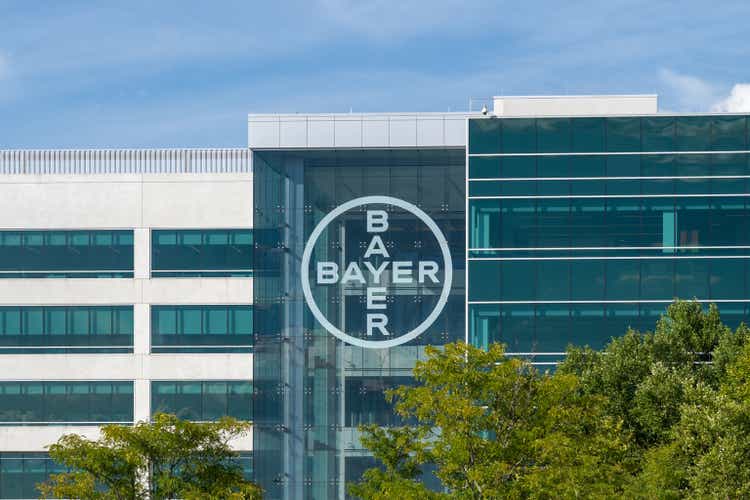
JHVEPhoto
One of my investments that was a huge disappointment in the recent past was the German life science company Bayer Aktiengesellschaft (OTCPK:BAYZF). Of course, one could argue that Bayer investors are now used to disappointments as the stock is now declining for almost 10 years and every time when investors assumed it couldn't get any worse, terrible new news came up and the stock was continuing to decline.
My last article about Bayer was published about three months ago following first quarter results and in my conclusion, I wrote:
Maybe I am a bit naïve and can’t see (or are too stubborn to see) the problems Bayer is faced with. But I still see value in the company and remain optimistic that the business can turn around. And after all, we have a business able to build a moat around itself and with several megatrends (growing population, aging population) on its side, the business should – in theory – have a prosperous future ahead of itself.
In the article, I was neutral overall and argued that I see small signs of improvement, but I also argued that these small signs of improvement are not enough. On August 6, 2024, Bayer was reporting second quarter results, and it is time for another update.
Second Quarter Results
Let’s start by looking at the results, which were nothing to get excited about but also no disappointment. Sales increased slightly from €11,044 million in Q2/23 to €11,144 million in Q2/24 – resulting in 0.9% year-over-year top-line growth. Volume increased 1.6% YoY and price increased 1.5% YoY, leading to FX and portfolio adjusted sales growth of 3.1%. And instead of a negative EBIT of €956 million in the same quarter last year, Bayer could report a positive EBIT of €525 million again. However, Bayer still had to report a loss per share and despite an improvement from a loss per share of €1.92 in Q2/23 to only a loss per share of 3 cents in Q2/24, the bottom line is still a disappointment.
We can also look at adjusted metrics, but EBITDA before special items also declined 16.5% year-over-year from €2,527 million in Q2/23 to €2,111 million in Q2/24. Core earnings per share from continued operations also declined 23.0% year-over-year from €1.22 in the same quarter last year to €0.94 this quarter.
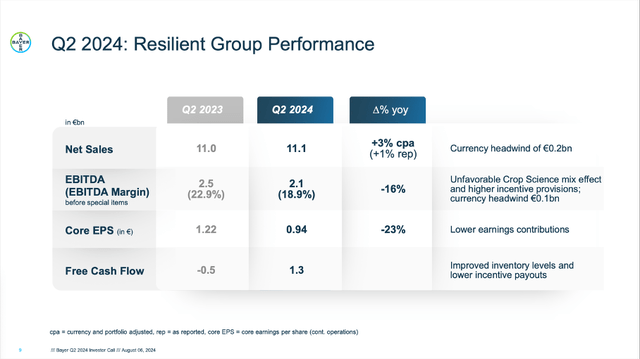
Bayer Q2/24 Presentation
While these metrics were not so great, Bayer could at least report a positive free cash flow €1,273 million this quarter after a negative FCF of €473 million in the same quarter last year. Like I said, not great results, but considering that Bayer investors seem to be used to getting horrible news from quarter to quarter, the second quarter results are acceptable.
Segment Results
We can also look at the three different segments in more detail and start by looking at Crop Sciences. While sales increased slightly from €4,924 million in Q2/23 to €4,981 million in Q2/24, EBITDA before special items declined 27.8% year-over-year from €725 million in the same quarter last year to €524 million this quarter. And while fungicides, herbicides (excluding glyphosate) and cotton declined in the double digits, it was especially glyphosate-based herbicides growing with a high pace – 42% year-over-year to €685 million in quarterly sales. Growth here was driven by a 12% price increase, but especially by 30% volume growth.
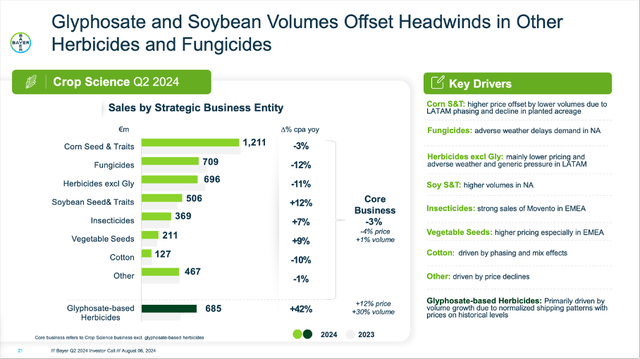
Bayer Q2/24 Presentation
While Crop Sciences is still struggling a bit, Pharmaceuticals performed a little bit better. Sales also increased a little bit from €4,557 million in the same quarter last year to €4,605 million this quarter. EBITDA before special items also declined, but only 4.1% from €1,379 million to €1,322 million. Growth was especially driven by blockbuster Eylea, which grew 8% year-over-year to €843 million in quarterly revenue. And Nubeqa, which has already reached blockbuster status, grew 90% year-over-year to €380 million quarterly revenue. On the other hand, Xarelto sales declined 11% YoY due to generic pressure, especially in Canada and Europe, but the drug is still generating €904 million in quarterly sales.
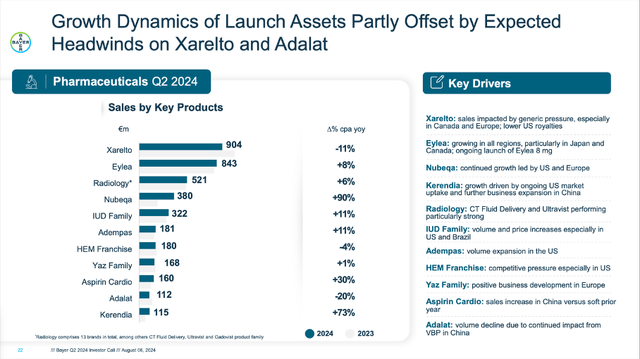
Bayer Q2/24 Presentation
And finally, Consumer Health sales also declined slightly from €1,466 million in Q2/23 to €1,458 million in Q2/24. EBITDA before special items also declined 6.3% year-over-year from €335 million in the same quarter last year to €314 million this quarter. However, we should point out that currency effects had a negative impact here and adjusted for currency, sales would have grown 5% year-over-year. And aside from Allergy & Cold, which declined 18% YoY, all other sub-segments grew at a solid pace. Pain & Cardio increased 9% and Nutritionals, Dermatology and Digestive increased even in the double digits.
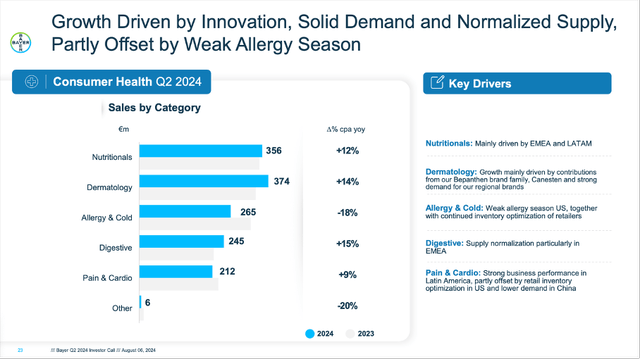
Bayer Q2/24 Presentation
Outlook 2024 Confirmed
And hand-in-hand with mediocre results, Bayer also confirmed its previous guidance for fiscal 2024 again. The guidance is also not great, but at least there is no major disappointment so far. Sales in fiscal 2024 (compared to the previous year) are expected to be between 1% decline and 3% growth (in constant currencies). The core EPS is expected to be in a range between €5.10 to €5.50 (compared to €6.39 in the previous year). And free cash flow is expected to be between €2.0 billion and €3.0 billion in fiscal 2024, compared to €1.3 billion in fiscal 2023.
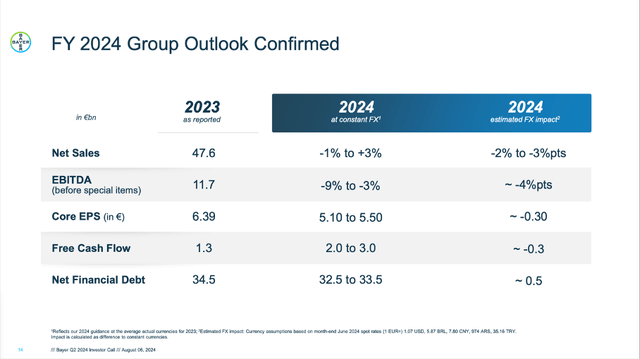
Bayer Q2/24 Presentation
And when looking at the different divisions, Crop Sciences will probably continue to struggle, and sales are expected to be in a range of 1% decline to 3% growth compared to fiscal 2023. Pharmaceuticals are expected to grow between 0% and 3% and Consumer Health sales are expected to increase between 3% and 6% (all numbers in constant currencies).
Risks: Debt and Litigations
So far, the results were not spectacular and there is no reason to be bullish or bearish. But when talking about Bayer, we can’t ignore the risks (which are still surrounding Bayer) as well as management’s efforts to restructure the business and turn the ship around. Let’s start with the risks – and when looking at the company’s top priorities, we also see the two major risks that need to be addressed.
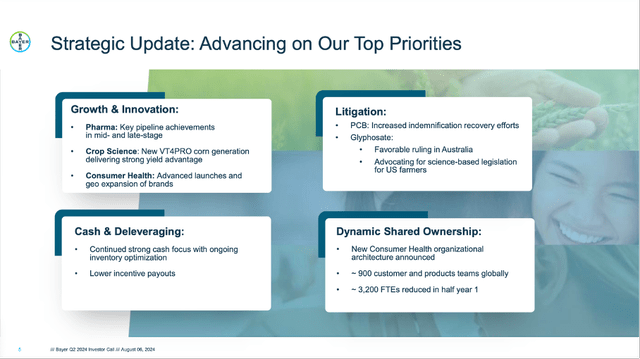
Bayer Q2/24 Presentation
Debt Levels
In the last few years, lowering debt levels was constantly a top priority for management (at least it seemed that way). But net financial debt did not really go lower. On June 30, 2024, the company still had €36,760 million in net financial debt on its balance sheet. And compared to the previous quarters (€37,488 million) net debt decreased, but when comparing the amount to six months earlier (€34,498 million) we see the company going in the wrong direction again. Nevertheless, let’s be optimistic and at the end of fiscal 2024, net financial debt is expected to be between €32.5 billion and €33.5 billion and management’s goal is to reduce debt in 2024. By the way, in the first half of 2024, Bayer had to spend €1,330 million in financial expenses (mostly interest payments). And when imagining that earnings per share could be about €2 higher for any fiscal year without the interest payments, we can see the huge impact the debt levels have on Bayer’s business.
Litigations
Aside from the debt levels, the ongoing legal matters are a huge burden for Bayer. During the last earnings call, CEO William N. Anderson gave an update on the Roundup litigations:
In the Roundup litigation, we achieved a very favorable decision from Down Under, where the Federal Court of Australia dismissed a class action. Once again, when it's really about science in the courtroom, we win. We've also seen positive developments in the U.S. Even the Philadelphia Court of Common Pleas, which is the most difficult court for companies as defendants in the U.S., they made some decisions in our favor in the most recent roundup case. And this ultimately led the plaintiff to dismiss the case. We consider this a great success.
Outside of the courts, we continue to explore measures to contain litigation risk. This involves partnering with American farmers who understand glyphosates’ great importance for their livelihoods and for global food security. We continue to focus on legislation at both the State and the Federal level, including advocating for the passage of a Farm Bill in Congress as early as possible. We want to see a bill passed that gives American farmers the reliability and the science-based regulation they deserve. We will continue to champion their voices. Further, we continue to evaluate every appropriate measure to bring closure to the situation, both for our company and for U.S. farmers, because we need our revenues to go to funding the company's mission, not the litigation industry.
And of course, Bayer’s management will present the situation rather optimistic during its earnings call. But I don’t know if we have many reasons to be optimistic at this point. The situation is hanging over Bayer and there have also been decisions in the recent past where Bayer had to pay huge amounts once again. In June 2024, for example, a Pennsylvania judge reduced a $2.25 billion verdict to $400 million, but this is still a huge amount Bayer must pay. Additionally, Bayer recently agreed to pay $160 million to settle a lawsuit by the city of Seattle, as Monsanto was also accused by the city of creating a public nuisance by manufacturing and marketing polychlorinated biphenyls, or PCBs, that allegedly fouled the municipal stormwater drainage system and contaminated the river. And while news stories of Bayer winning cases and Bayer losing cases go hand in hand, uncertainty remains, and the litigations are a burden for Bayer’s business until they are finally resolved.
Transforming The Business
And as we can see in the chart above, not only litigations and the deleveraging process are among the top priorities, but also the focus on growth and innovation and the strategic transformation. I already mentioned above the growth in the Pharmaceutical segment, which is solid and when adjusting for FX, the Consumer Health segment is also growing at a solid pace.
Aside from focusing on growth and innovation in all three business segments, the fourth priority is to transform Bayer from a “bureaucratic monster” to a modern business with a new organizational structure that is enabling quicker and better decisions. During the last earnings call, Anderson commented:
We're systematically installing a new way of operating across the whole company, and it's proceeding apace. We have 3,200 fewer jobs in the company than we did to start the year. And we've stood up 900 teams working on some of our most important missions. Our new Beckett [ph] team is fully schooled in the new model. And the business is growing in all regions, ahead of expectations, quarter-over-quarter and year-to-date. Our crop science team plans to roll out 10 blockbusters over the next 10 years and those 10 teams are among the 50 product teams that we've activated in crop science, each with the sole goal of improving the solutions we develop for the world's farmers.
And although it will take some time before such a business transformation is visible in the top and bottom line of Bayer, I remain confident that Anderson knows what he is doing.
Conclusion
Summing up, I will keep my neutral rating at this point, and I, personally, will also keep my Bayer shares and remain convinced that Bayer can return to being a business it once was (before 2015). However, at this point, I don’t see many reasons to buy the stock, and I can understand when people are waiting for better results before purchasing Bayer. Of course, we are always risking that the stock might suddenly jump to much higher prices when good news are getting priced in, but that is a decision everybody has to make for him- or herself: accepting higher levels for risk for a potentially higher return or avoiding high risk and therefore risking lower returns.
Editor's Note: This article discusses one or more securities that do not trade on a major U.S. exchange. Please be aware of the risks associated with these stocks.
Disclaimer: Investing carries risk. This is not financial advice. The above content should not be regarded as an offer, recommendation, or solicitation on acquiring or disposing of any financial products, any associated discussions, comments, or posts by author or other users should not be considered as such either. It is solely for general information purpose only, which does not consider your own investment objectives, financial situations or needs. TTM assumes no responsibility or warranty for the accuracy and completeness of the information, investors should do their own research and may seek professional advice before investing.

